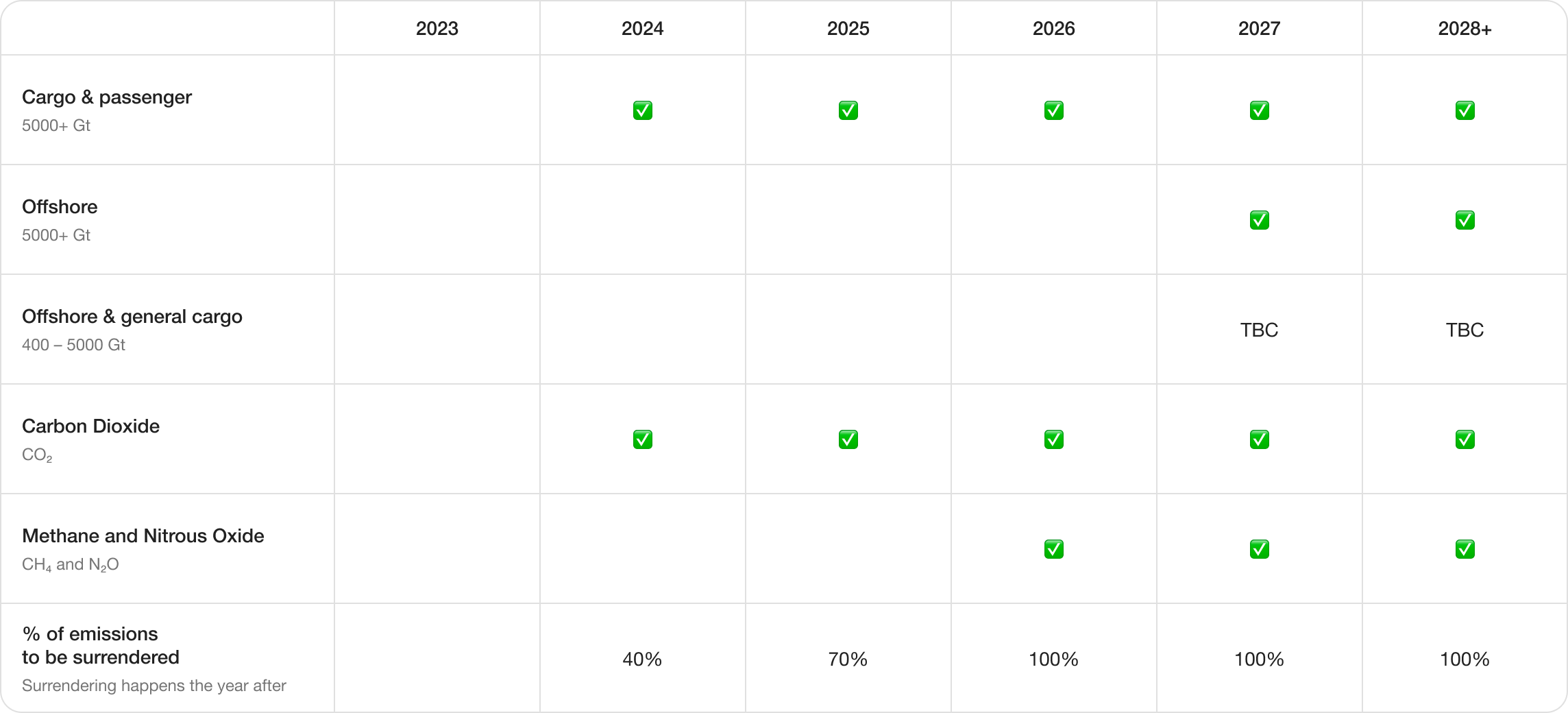EU ETS surcharge explorer
Explore how EU ETS surcharges vary across carriers and trade lanes, how it compares with Lune’s own estimates, and get the answers to your EU ETS questions below. Carrier surcharge data from CMA CGM, COSCO, Evergreen, Hapag-Lloyd, MSC, ONE. Last updated March 2024.Asia to Mediterranean
Asia to Mediterranean, 1 TEU
Vessel | Carrier surcharge | Lune estimate | Difference |
|---|---|---|---|
EVER Top | € 23.00 | € 18.57 | 124 % |
CGA CGM Galapagos | € 20.00 | € 10.18 | 196 % |
COSCO Nebula | € 19.00 | € 8.94 | 213 % |
The EVER Top is in service between East Asia and the Mediterranean, via The Cape due to the Red Sea crisis.
Our estimate includes 50% of CO₂ emissions produced between Singapore and Piraeus, plus 100% emissions between Piraeus and Genoa, as required by ETS.
The takeaway
Carriers overcharge 2–3×: every carrier charges more than the EU ETS surcharge should be, according to Lune’s estimates.
Charging €5–20 extra per TEU seems marginal, especially considering the total cost of the shipment. However, it adds up!
For example:
- COSCO Hope @ 13,000 TEU capacity: €440,700 profit
- CMA CGA Galapagos @15,000 TEU capacity: €147,300 profit
- MSC Fiammetta @ 5,760 TEU capacity: €58,060 profit
This may not be fully profiteering, but the carriers may also be adding a buffer to account for administrative work, EUA price fluctuations (which can be high), or simply applying a different calculation method (e.g. charging for 100% of emissions instead of the 40% required by the EU ETS).
FAQs
What is the EU Emissions Trading System (EU ETS)?
What is the EU Emissions Trading System (EU ETS)?
Companies affected by this policy must annually report on their emissions through the EU MRV (Monitoring, Reporting, and Verification) system, and “surrender/use“ purchased ETS allowances (EUAs) to cover these emissions.
Effectively, it’s a tax. The aim is to make producing emissions more expensive. Thus, incentivising rapid decarbonisation.
What are European Union Allowances (EUAs)?
What are European Union Allowances (EUAs)?
I've already offset my emissions, will they still need to be covered by EUAs?
I've already offset my emissions, will they still need to be covered by EUAs?
Does the EU ETS include maritime shipping?
Does the EU ETS include maritime shipping?
As of 2024, carriers will need to report on and pay the allowances to cover the CO₂ emissions for:
- Cargo and passenger ships of or above 5000 gross tonnage (GT)
- 100% of the emissions from intra-EU maritime voyages
- 100% of emissions from ships at berth in EU ports
- 50% of emissions from voyages which start or end at EU ports, where the other destination is outside of the EU
Who's responsible for reporting emissions and surrendering allowances?
Who's responsible for reporting emissions and surrendering allowances?
Learn more.
What are EU ETS surcharges?
What are EU ETS surcharges?
It’s important to note that each ‘surcharge‘ is created by individual carriers. Meaning how they calculate the charge, or even the form a surcharge might take can vary from carrier to carrier. For example, some carriers may decide to cover the cost through carbon insetting, bio-fuel shipments, or other alternatives.
How do carriers calculate the EU ETS surcharge?
How do carriers calculate the EU ETS surcharge?
CO₂ Emissions per TEU × EUAs price
However, the reality is not that simple.
- Carriers collect surcharges before the shipment has taken place, when the shipment emissions aren’t known yet
- EUA price fluctuates over time
- Carriers bear admin costs for reporting emissions to the EU ETS
How does Lune estimate the ETS cost incurred by carriers?
How does Lune estimate the ETS cost incurred by carriers?
- We calculate the emissions of each vessel for shipping 1 TEU on each route displayed above
- We only consider 40% of CO₂ emissions, and ignore other GHG gases
- We consider whether one or both ports are within the EEA (50% or 100% emissions considered)
- We multiply the emissions by the 2023 EUA average price of € 80 / tCO₂e
How will the EU ETS scheme change in the future?
How will the EU ETS scheme change in the future?
The price of EUAs is expected to increase in the long-term, particularly as the EU reduces supply to reflect the greater cost of emitting. In economic terms, greater demand and smaller supply means higher prices. Unless fleets are rapidly decarbonised, shippers could expect surcharge prices to hike over the coming years.
Learn more about EUAs.

Greening the supply
chain
Explore the environmental impact of supply chains, investigate the push and pull factors changing the logistic landscape, and strategies sustainability leaders are already implementing to reach net zero.